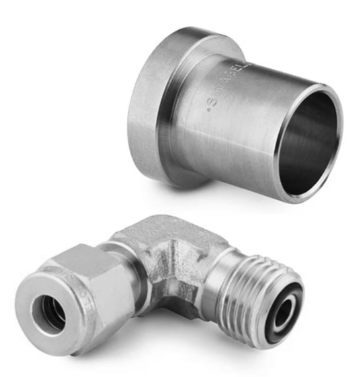VCO fittings, or Vacuum Clamp fittings, are specialized connectors designed for high-pressure, high-temperature, and corrosive environments. They provide a reliable and leak-proof seal, making them essential in various industrial applications.
Safety and precision are paramount in piping systems, especially those handling hazardous materials or critical processes. Leaks can lead to accidents, environmental hazards, and operational disruptions. Precise connections ensure optimal system performance and prevent inefficiencies.
Key Industries and Applications that Rely on VCO Fittings
VCO fittings are widely used across various industries, including:
➡️ Oil and gas: Exploration, production, and refining
➡️ Chemical processing: Manufacturing and handling of chemicals
➡️ Pharmaceutical: Production of pharmaceuticals and biopharmaceuticals
➡️ Semiconductor: Manufacturing of electronic components
➡️ Power generation: Nuclear, fossil fuel, and renewable energy plants
Understanding the Design and Function of VCO Fittings
Anatomy of a VCO fitting: Components and materials used.
A typical VCO fitting consists of a clamp body, a gasket, and a nut. The clamp body is typically made of high-strength materials like stainless steel, while the gasket can be made of various materials depending on the application, such as graphite or PTFE.
How the metal-to-metal seal works for leak-proof connections.
The unique feature of VCO fittings is the metal-to-metal seal. When the nut is tightened, the clamp body applies pressure to the gasket, creating a tight seal between the two mating surfaces. This ensures a leak-proof connection, even under extreme conditions.
Unique features that enhance precision and reliability.
➡️ Torque control: VCO fittings require precise torque control during installation to ensure proper sealing and prevent over-tightening.
➡️ Vibration resistance: The design of VCO fittings makes them resistant to vibration, ensuring the connection remains secure in dynamic environments.
➡️ Corrosion resistance: The materials used in VCO fittings are often chosen for their corrosion resistance, making them suitable for harsh environments.
Minimizing leak risks: How VCO fittings create secure seals.
The metal-to-metal seal in VCO fittings provides a highly reliable and leak-proof connection. This minimizes the risk of leaks, which can lead to accidents, environmental hazards, and operational disruptions.
Corrosion resistance and material durability in hazardous environments.
VCO fittings are often made of materials that are resistant to corrosion and can withstand harsh environments. This ensures the longevity and reliability of the fittings, even in challenging conditions.
Ensuring system integrity in high-pressure and high-temperature conditions.
VCO fittings are designed to handle high pressures and temperatures without compromising the seal. This makes them ideal for applications where system integrity is critical.
Precision Engineering: How VCO Fittings Optimize Performance
Consistent torque control for repeatable and precise installations.
Proper torque control is essential for ensuring a reliable seal in VCO fittings. Consistent torque control helps to prevent over-tightening or under-tightening, which can lead to leaks or damage to the fitting.
Reducing vibration and maintaining alignment in dynamic systems.
VCO fittings are designed to be resistant to vibration, which helps to maintain the alignment of the connection and prevent leaks. This is particularly important in dynamic systems where vibration is common.
Achieving tight tolerances for sensitive piping setups.
VCO fittings can be used to achieve tight tolerances in sensitive piping setups. This is important in applications where precise control of flow or pressure is required.
Comparing VCO Fittings to Other Connector Options
VCO Fittings vs. Compression Fittings: Pros and cons
Compression fittings are another type of connector commonly used in piping systems. While both VCO and compression fittings provide a reliable seal, VCO fittings are generally considered more suitable for high-pressure, high-temperature, and corrosive environments. Compression fittings are often used in lower-pressure applications.
Differences between VCO and VCR fittings in critical applications
VCR fittings are another type of specialized connector used in critical applications, such as those involving high-purity gases or liquids. While both VCO and VCR fittings offer high levels of performance, VCR fittings may be preferred in certain applications due to their unique design and materials.
When to choose VCO fittings for safety and precision
VCO fittings are an excellent choice for applications where safety and precision are critical. They are particularly well-suited for high-pressure, high-temperature, and corrosive environments.
Installation Best Practices for VCO Fittings
Step-by-step guide to proper installation and assembly
Proper installation of VCO fittings is essential for ensuring a reliable seal. Follow the manufacturer’s instructions carefully, including the recommended torque settings.
Common mistakes to avoid when using VCO fittings
➡️ Over-tightening: This can damage the gasket or the fitting itself.
➡️ Under-tightening: This can lead to leaks.
➡️ Incorrect gasket selection: Using the wrong gasket material can compromise the seal.
Maintenance tips to prolong the lifespan of VCO fittings.
Regular inspection and maintenance can help to prolong the lifespan of VCO fittings. This includes checking for leaks, tightening loose connections, and replacing worn gaskets.
Conclusion
VCO fittings are essential components in piping systems where safety and precision are paramount. Their unique design and materials provide a reliable and leak-proof seal, even in harsh environments.
By understanding the benefits of VCO fittings and following proper installation practices, you can ensure the optimal performance and safety of your piping systems.
Post time: Oct-10-2024


